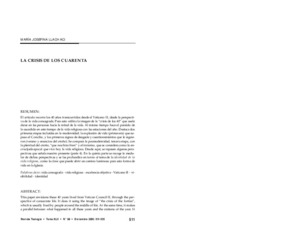Please use this identifier to cite or link to this item:
https://repositorio.uca.edu.ar/handle/123456789/18203| Título: | La crisis de los cuarenta | Autor: | Llach, María Josefina | Palabras clave: | VIDA CONSAGRADA; VIDA RELIGIOSA; IDENTIDAD | Fecha de publicación: | 2005 | Editorial: | Pontificia Universidad Católica Argentina. Facultad de Teología | Cita: | Llach, M. J. La crisis de los cuarenta [en línea]. Teología. 2005, 42 (88). Disponible en: https://repositorio.uca.edu.ar/handle/123456789/18203 | Resumen: | Resumen: El artículo recorre los 40 años transcurridos desde el Vaticano II, desde la perspectiva
de la vida consagrada. Para esto utiliza la imagen de la “crisis de los 40” que suele
darse en las personas hacia la mitad de la vida. Al mismo tiempo hace el paralelo de
lo sucedido en este tiempo de la vida religiosa con las estaciones del año. Destaca dos
primeras etapas incluidas en la modernidad: la explosión de vida (primavera) que supuso
el Concilio, y los primeros signos de desgaste y cuestionamientos que le siguieron
(verano y anuncios del otoño). Se compara la posmodernidad, tercera etapa, con
la plenitud del otoño, “que nos hizo bien” y el invierno, que se considera como la encrucijada
epocal que vive hoy la vida religiosa. Desde aquí, se repasan algunas perspectivas
que señala nuestro presente (parte 4). En la quinta parte se recoge lo medular
de dichas perspectivas y se las profundiza en torno al tema de la identidad de la
vida religiosa, como la clave que puede abrir un camino luminoso para esta forma de
vida en la Iglesia. Abstract: This paper envisions these 40 years lived from Vatican Council II, through the perspective of consecrate life. It does it using the image of “the crisis of the forties”, which is usually lived by people around the middle of life. At the same time, it makes a parallel between what happened in all these years and the stations of the year. It highlights two initial stages included in Modernity: the explosion of life (spring) that the Council brought about, and the first signs of wear and tear, as well as controversies that followed up (summer and announcements of autumn). It then compares post modernity, the third stage, with the fullness of autumn, “which was positive for us”, and winter, which is considered as a crossroads of this time such as it is lived today by Religious life. From here on, it goes over some perspectives made possible by our present (part 4). Part 5 picks up the core of those perspectives and it deepens into the identity of Religious life, as the key to a new path full of life for this call in our Church today. |
URI: | https://repositorio.uca.edu.ar/handle/123456789/18203 | ISSN: | 0328-1396 (impreso) 2683-7307 (online) |
Disciplina: | TEOLOGIA | Derechos: | Acceso abierto | Fuente: | Teología. 2005, 42 (88) |
| Appears in Collections: | TEO - 2005 Tomo XLII nro. 088 |
Files in This Item:
| File | Description | Size | Format | |
|---|---|---|---|---|
| crisis-cuarenta.pdf | 79,12 kB | Adobe PDF |  View/Open |
This item is licensed under a Creative Commons License

